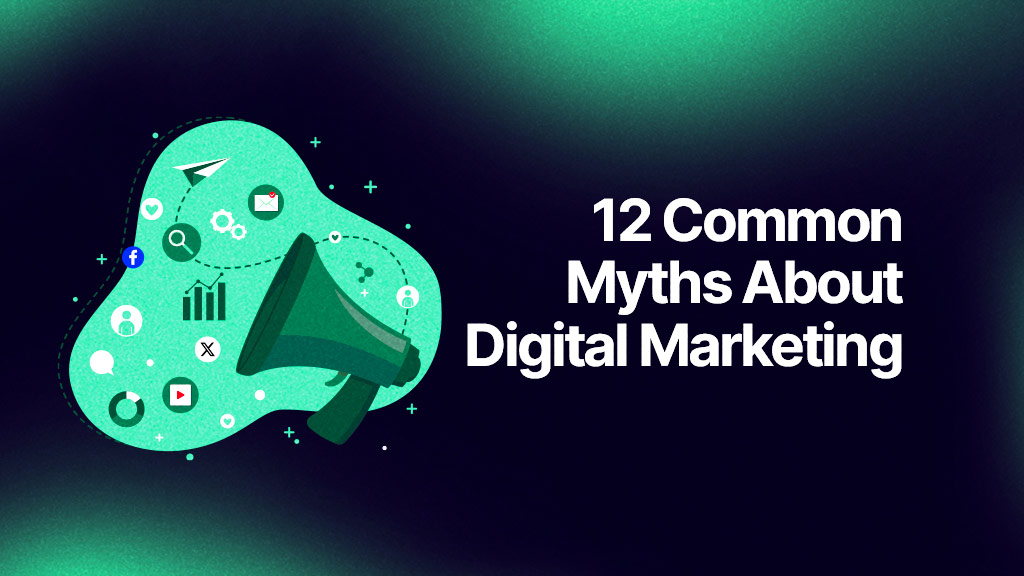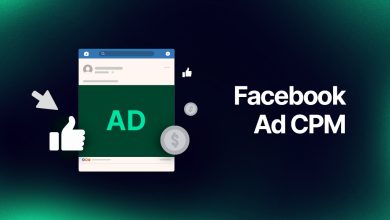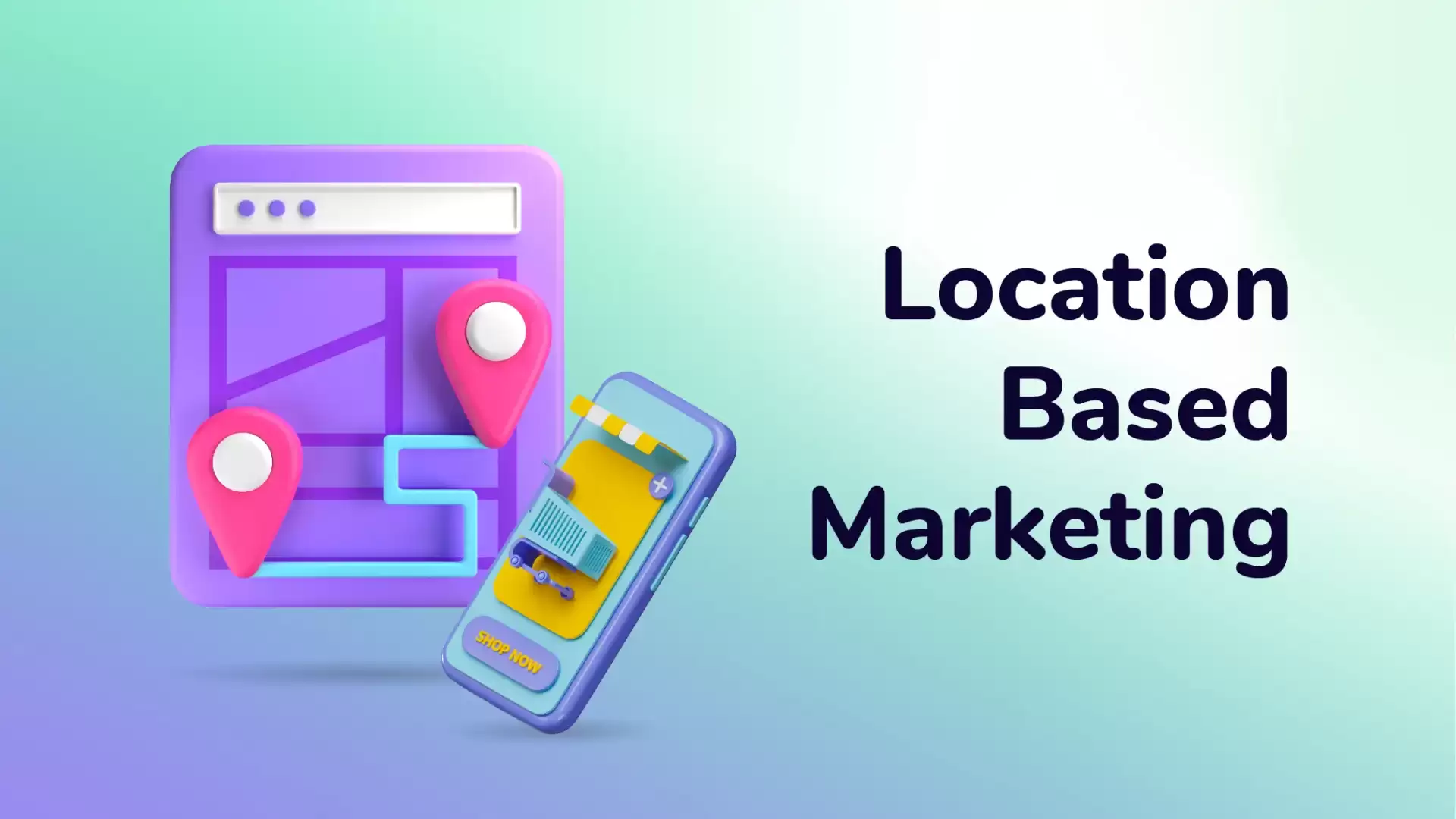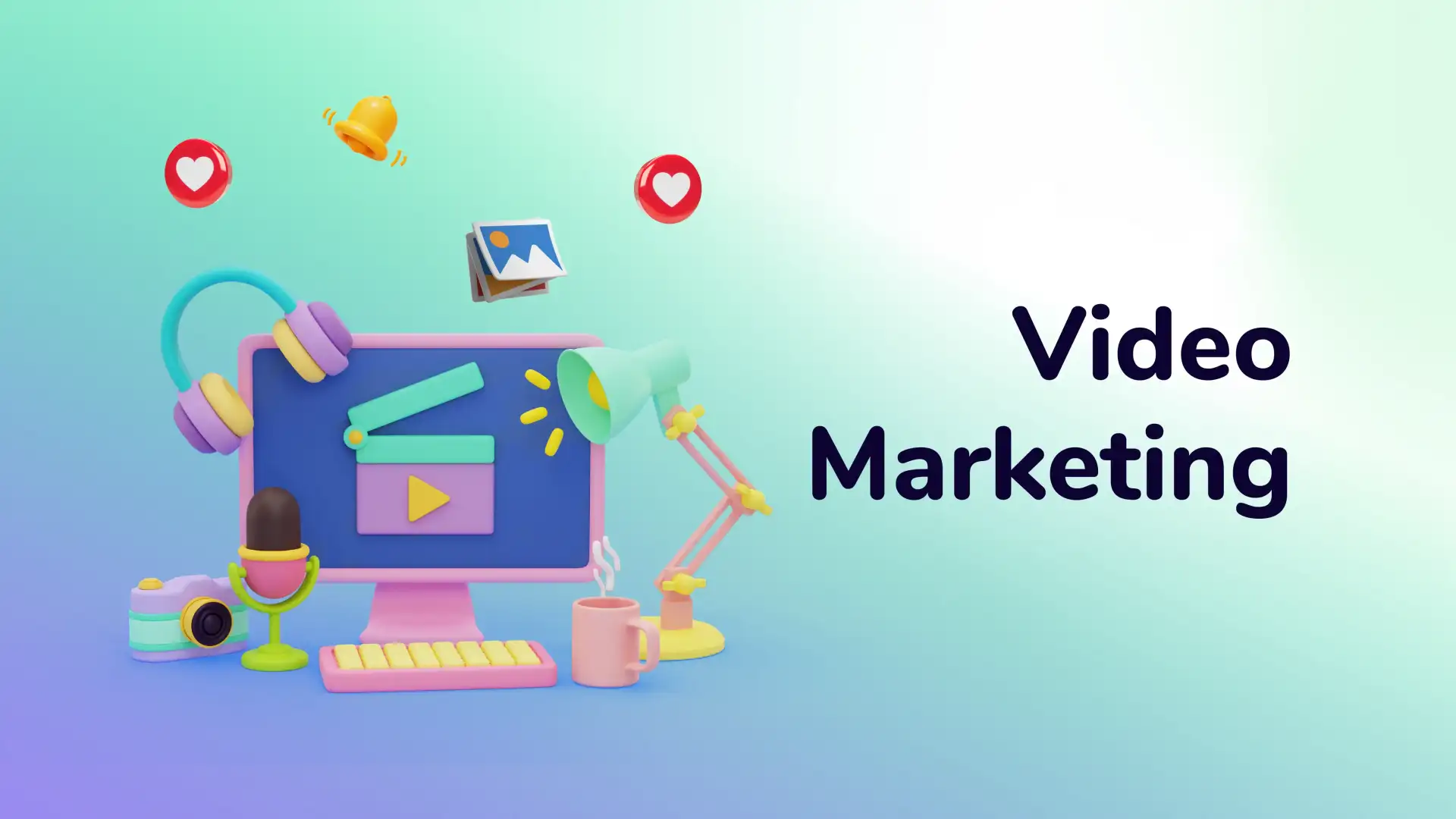12 Common Myths About Digital Marketing

Table of Contents
- Most Common Digital Marketing Myths
- 1. Digital Marketing is Only for Big Businesses
- 2. SEO is Dead
- 3. Mobile Conversions Don’t Happen
- 4. You Can Set It and Forget It
- 5. Email Marketing is Dead
- 6. Content isn’t Important
- 7. Digital Marketing is Expensive
- 8. You Must Be on Every Social Media Platform
- 9. More Followers Equals More Sales
- 10. Results Happen Overnight
- 11. Negative Comments on Social Media are Always Bad
- 12. Once You Build a Website, You’re Done
Digital marketing myths and misconceptions exist in the quickly evolving world of digital marketing, often clouding the understanding of its true potential and effectiveness. These myths can hold businesses back from achieving their full potential online, limiting their ability to connect with customers and drive growth.
In this guide, we debunk 12 common digital marketing myths, providing clarity and insights to help businesses navigate this dynamic landscape with confidence and success.
From the digital marketing myths 2025 about its affordability to the misconception of “set it and forget it” strategies, we debunk the truth behind common digital marketing myths to help businesses make informed decisions and use digital marketing strategies effectively. Join us as we separate facts from the myths about digital marketing and uncover the realities of digital marketing in today’s digital age.
Most Common Digital Marketing Myths
- Digital Marketing is Only for Big Businesses
- SEO is Dead
- Mobile Conversions Don’t Happen
- You Can Set It and Forget It
- Email Marketing is Dead
- Content isn’t Important
- Digital Marketing is Expensive
- You Must Be on Every Social Media Platform
- More Followers Equals More Sales
- Results Happen Overnight
- Negative Comments on Social Media are Always Bad
- Once You Build a Website, You’re Done
1. Digital Marketing is Only for Big Businesses
It’s one of the common myths of digital marketing that digital marketing is a game reserved only for big players with deep pockets. In reality, digital platforms have democratized marketing, offering cost-effective avenues for businesses of all sizes to compete effectively.
Small and medium-sized enterprises (SMEs), startups, and even solopreneurs can use digital marketing to reach their target audience without breaking the bank. Social media platforms, for example, provide powerful tools for engagement and brand building at minimal costs.
Moreover, the introduction of digital marketing automation tools and data analytics has further leveled the playing field. These tools allow businesses to streamline their marketing efforts, optimize strategies in real-time, and target specific audience segments with precision.
In essence, digital marketing offers scalability, affordability, and targeting capabilities that make it accessible and effective for businesses of all sizes. It’s not about the size of the budget but the strategic use of digital resources that determines success in the digital marketplace. So this is the first one of the digital marketing myths that is not correct, what’s next?
2. SEO is Dead

One of the persistent digital marketing myths is that Search Engine Optimization (SEO) is outdated. This myth overlooks the ongoing importance of organic search visibility in digital marketing strategies. While SEO strategies have evolved over time in response to changes in search engine algorithms and user behaviors, the fundamental principles remain critical to online success.
Far from being extinct, SEO is alive and thriving, although in a transformed landscape. Modern SEO is a comprehensive strategy for website optimization, content creation, and user experience enhancement aimed at improving search engine rankings and driving organic traffic.
Search engines like Google continuously refine their algorithms to deliver more relevant and authoritative content to users. As such, SEO strategies have adapted to prioritize factors such as high-quality content, mobile-friendliness, website speed, and user engagement metrics.
Moreover, the rise of voice search, local search optimization, and featured snippets has expanded the scope of SEO beyond traditional keyword targeting, presenting new opportunities for businesses to improve their online visibility and attract qualified traffic.
Basically, far from this digital marketing myth, SEO remains a cornerstone of digital marketing, offering long-term benefits and sustainable growth opportunities for businesses willing to invest in optimizing their online presence for search engines.
3. Mobile Conversions Don’t Happen
The digital marketing myths that mobile conversions are rare overlooks the significant shift in consumer behavior towards mobile devices in recent years. With smartphones and tablets becoming more common, mobile has emerged as a dominant platform for online activities, including shopping and transactional interactions.
In reality, mobile conversions not only happen but are increasingly prevalent in today’s digital landscape. Studies consistently show a growing trend in mobile commerce, with a significant portion of online purchases initiated and completed on mobile devices.
Businesses that optimize their websites and marketing strategies for mobile users stand to benefit from this trend. Mobile-responsive design, intuitive navigation, and streamlined checkout processes are key elements in facilitating mobile conversions and providing a seamless user experience across devices.
Moreover, the integration of mobile-specific features such as click-to-call buttons, location-based services, and mobile wallets further increases the likelihood of conversions on mobile devices. By using these tools and tailoring their marketing efforts to mobile users, businesses can profit from the growing opportunities presented by the mobile-first mindset of modern consumers.
In summary, dismissing mobile conversions as improbable is one of the digital marketing myths and facts that fails to acknowledge the undeniable influence of mobile technology on consumer behavior. By prioritizing mobile optimization and adapting their strategies to meet the needs of mobile users, businesses can unlock new avenues for growth and benefit from the huge potential of the mobile marketplace.
4. You Can Set It and Forget It
One of the digital marketing myths that digital marketing can be automated and left to run without ongoing attention overlooks the dynamic nature of online platforms and consumer behaviors. While automation tools can streamline certain processes, successful digital marketing requires continuous monitoring, optimization, and adaptation to remain effective.
In reality, the “set it and forget it” approach is a recipe for stagnation and missed opportunities in the fast-paced world of digital marketing. Algorithms change, trends evolve, and consumer preferences shift over time, necessitating regular adjustments to marketing strategies to stay relevant and competitive.
Businesses that embrace a proactive approach to digital marketing are better positioned to benefit from emerging opportunities and eliminate potential risks. Whether it’s updating content to reflect current trends, refining targeting parameters based on performance data, or experimenting with new channels and tactics, ongoing optimization is essential for maintaining momentum and driving results.
Unlike the digital marketing misconceptions, customer expectations are constantly evolving in response to market dynamics and competitor actions. By remaining attentive and responsive to feedback, businesses can build stronger relationships with their audience and adapt their marketing efforts to meet evolving needs and preferences.
In essence, digital marketing is not a one-time endeavor but an ongoing journey of exploration, experimentation, and refinement. By abandoning this digital marketing myths in favor of a mindset of continuous improvement, businesses can position themselves for sustained success in the ever-changing digital landscape.
5. Email Marketing is Dead

One of the top digital marketing myths is that email marketing has lost its relevance in the era of social media and instant messaging overlooks its enduring effectiveness as a direct and personalized communication channel. Contrary to popular belief, email marketing remains a powerful tool for engaging with audiences, nurturing leads, and driving conversions.
In reality, email marketing continues to deliver impressive returns on investment (ROI) for businesses across various industries. With an estimated 4.3 billion email users worldwide, email remains one of the most widely used and accessible communication platforms, offering unparalleled reach and scalability.
Moreover, advancements in email marketing automation and personalization have further increased its effectiveness. Businesses can use segmentation, dynamic content, and behavioral triggers to deliver highly targeted and relevant messages to their subscribers, increasing engagement and conversion rates.
Furthermore, email marketing offers a level of ownership and control that other marketing channels lack. Unlike social media platforms, where algorithm changes and platform policies can impact reach and visibility, businesses retain full control over their email lists and communication strategies, allowing for greater autonomy and flexibility.
6. Content isn’t Important
One of the digital marketing myths is that content is unimportant, despite its critical role in digital marketing as the cornerstone of engagement, credibility, and brand storytelling. In reality, high-quality content lies at the heart of successful digital marketing strategies, serving as a vehicle for delivering value, building trust, and driving action.
In today’s digital landscape, where consumers are bombarded with information and choices, captivating content is essential for grabbing and retaining audience attention. Whether it’s blog posts, videos, infographics, or social media updates, engaging content serves as a magnet, drawing audiences into the brand’s narrative and building meaningful connections.
Moreover, content plays an important role in search engine optimization (SEO), with search algorithms favoring websites that produce relevant, informative, and authoritative content. By consistently publishing valuable content that addresses audience needs and interests, businesses can improve their search visibility and attract organic traffic to their websites.
Furthermore, content serves as a platform for showcasing expertise, thought leadership, and unique brand personality. By sharing valuable insights, industry knowledge, and interesting storytelling, businesses can position themselves as trusted authorities in their respective fields, earning the loyalty and respect of their audience.
Dismissing the importance of content in digital marketing is a mistake that ignores its central role in driving engagement, building credibility, and establishing brand identity. By prioritizing the creation of high-quality, relevant content, businesses can differentiate themselves in a crowded marketplace, connect authentically with their audience, and achieve sustainable growth and success.
7. Digital Marketing is Expensive
The digital marketing myths that digital marketing is expensive ignores the diverse range of cost-effective strategies and tools available to businesses of all sizes. In reality, digital marketing offers unparalleled flexibility and scalability, allowing organizations to tailor their strategies to fit their budgets and objectives.
While some digital marketing tactics may require investment, the ROI potential far outweighs the upfront costs. Unlike traditional forms of marketing that often entail significant expenses for ad space or production, digital channels offer more affordable alternatives, such as pay-per-click (PPC) advertising, social media marketing, and email campaigns.
Unlike this digital marketing myth, the ability to target specific audience segments with precision allows businesses to optimize their marketing spend and maximize efficiency. By using data analytics and performance metrics, organizations can identify the most effective channels and tactics for reaching their target audience and allocate resources accordingly.
Furthermore, the introduction of marketing automation tools has further democratized digital marketing, allowing businesses to streamline their processes and optimize their workflows without the need for a large marketing team.
Automation platforms offer features such as email marketing automation, social media scheduling, and customer relationship management (CRM) integration, enabling organizations to achieve more with fewer resources.
While digital marketing may require investment, it offers a high ROI potential and unparalleled opportunities for businesses to reach and engage their target audience cost-effectively. Organizations can achieve their marketing objectives without breaking the bank by adopting a strategic approach and using the diverse range of digital marketing tools and tactics available.
8. You Must Be on Every Social Media Platform

One of the digital marketing myths is that businesses need to maintain a presence on every social media platform overlooks the importance of strategic focus and audience targeting in digital marketing efforts. In reality, while social media can be a valuable tool for engaging with audiences and building brand awareness, not every platform is suitable for every business.
Each social media platform has its unique demographics, features, and user behaviors. Instead of spreading resources thinly across multiple platforms, businesses should focus on identifying the platforms where their target audience is most active and engaged.
By doing audience research and analyzing demographic data, businesses can determine which social media channels align best with their target market and objectives. For example, a visually oriented brand may find success on platforms like Instagram or Pinterest, while a B2B company may prioritize LinkedIn for professional networking and lead generation.
Maintaining an active presence on multiple social media platforms can be resource-intensive and may reduce the effectiveness of marketing efforts. By concentrating efforts on select platforms, businesses can allocate resources more effectively, allowing for deeper engagement and more targeted messaging.
The belief that businesses must be present on every social media platform is a misconception that can lead to inefficiency and wasted resources. By focusing on the platforms that offer the greatest potential for reaching and engaging their target audience, businesses can increase the impact of their social media marketing efforts and achieve their objectives more effectively.
9. More Followers Equals More Sales
The misconception that a large following directly translates to increased sales ignores the quality versus quantity dynamic in social media marketing. In reality, while a sizable following may indicate brand popularity, the true measure of social media success lies in engagement, conversion, and customer loyalty.
Having a large number of followers does not guarantee sales or meaningful interactions. In fact, an engaged and loyal audience of a smaller size can be far more valuable than a large but passive following. It’s not just about the numbers; it’s about the depth of connection and the level of engagement with your audience.
Businesses should prioritize building relationships with their followers, building meaningful interactions, and providing value through their content and offerings. By focusing on quality engagement rather than follower count, businesses can build a community of loyal advocates who are more likely to convert and recommend the brand to others.
Social media algorithms prioritize content that generates genuine engagement and interaction. Therefore, a highly engaged audience is more likely to see and interact with your content, increasing its reach and effect.
While a large following can indicate brand visibility, it’s the quality of engagement and the depth of connection with followers that ultimately drive sales and business success on social media. By prioritizing meaningful interactions and providing value to their audience, businesses can create loyalty, trust, and advocacy. It leads to increased sales and sustainable growth.
10. Results Happen Overnight
One of the digital marketing myths is that digital marketing produces instant results ignores the reality of building sustainable, long-term success in the digital landscape. Effective digital marketing requires patience, persistence, and strategic planning to achieve meaningful results over time.
While certain marketing tactics, such as pay-per-click (PPC) advertising, can generate immediate traffic and leads, sustainable growth typically requires a more comprehensive approach. Building brand awareness, establishing credibility, and nurturing customer relationships are processes that take time to develop and yield tangible results.
Moreover, the digital marketplace is highly competitive, with countless businesses competing for the attention of consumers. Standing out from the noise requires consistent effort, experimentation, and optimization to refine strategies and drive continuous improvement.
Unlike this myth, Businesses should set realistic expectations for their digital marketing efforts, understanding that meaningful results often require an investment of time and resources. By focusing on long-term objectives and implementing sustainable growth strategies, businesses can achieve lasting success in the digital world.
The belief that digital marketing delivers overnight results is a misconception that fails to acknowledge the complexities of building a strong online presence and driving meaningful engagement. By adopting a patient and strategic approach, businesses can lay the foundation for sustainable growth and success in the digital marketplace.
11. Negative Comments on Social Media are Always Bad

The digital marketing myth that negative comments on social media are always harmful overlooks the potential for positive feedback and engagement opportunities. In reality, negative comments can provide valuable insights into customer perceptions, preferences, and pain points, presenting businesses with an opportunity to demonstrate transparency, responsiveness, and commitment to customer satisfaction.
While negative comments may initially seem undesirable, they offer a chance for businesses to showcase their dedication to addressing customer concerns and resolving issues promptly. By responding thoughtfully and empathetically to negative feedback, businesses can turn critics into advocates, creating trust, loyalty, and goodwill among their audience.
Public displays of transparency and accountability can improve brand credibility and authenticity, showcasing a willingness to listen, learn, and improve based on customer feedback. Rather than viewing negative comments as a threat, businesses should embrace them as valuable opportunities for growth and relationship building.
Additionally, addressing negative comments publicly demonstrates to other customers that their concerns are taken seriously and that the business is committed to providing exceptional service and support. This transparency can help limit potential damage to brand reputation and preserve customer trust and loyalty in the long run.
Negative comments on social media are not inherently negative; they are opportunities for businesses to demonstrate their commitment to customer satisfaction and showcase their brand values. By responding proactively and authentically to negative feedback, businesses can turn challenges into opportunities for growth, relationship building, and brand enhancement.
12. Once You Build a Website, You’re Done
The digital marketing myth that building a website marks the end of digital marketing activities ignores the changing nature of the online landscape and the ongoing need for website maintenance, optimization, and content updates. In reality, a website is not a static entity but a living digital asset that requires continuous attention and refinement to remain effective and competitive.
While creating a website is an important first step in establishing an online presence, it’s just the beginning of the journey. Regular updates, performance optimizations, and security improvements are essential to ensuring a positive user experience and maintaining search engine visibility.
Consumer preferences and technological advancements evolve over time, necessitating periodic website redesigns or improvements to stay relevant and meet user expectations. By remaining up to date on industry trends and user behaviors, businesses can adapt their websites to reflect changing needs and preferences.
Furthermore, content creation and optimization are ongoing processes that are critical for driving traffic, engagement, and conversions. Fresh, relevant content not only keeps visitors engaged but also signals to search engines that the website is active and authoritative, improving its search rankings over time.
The belief that building a website marks the conclusion of digital marketing efforts is a misconception that fails to recognize the continuous nature of website management and optimization.
By treating the website as a dynamic and evolving asset and investing in ongoing maintenance and content updates, businesses can increase its effectiveness as a marketing tool and achieve long-term success online.
Dispelling these common digital marketing myths and truths is crucial for businesses seeking to navigate the digital landscape successfully. By understanding myths and facts about digital marketing and adopting strategic approaches, businesses can use their full potential to reach and engage their target audience effectively.
Ready to boost your ad performance? Discover how our expert PPC optimization services can help you maximize ROI and stay ahead in the digital game.




